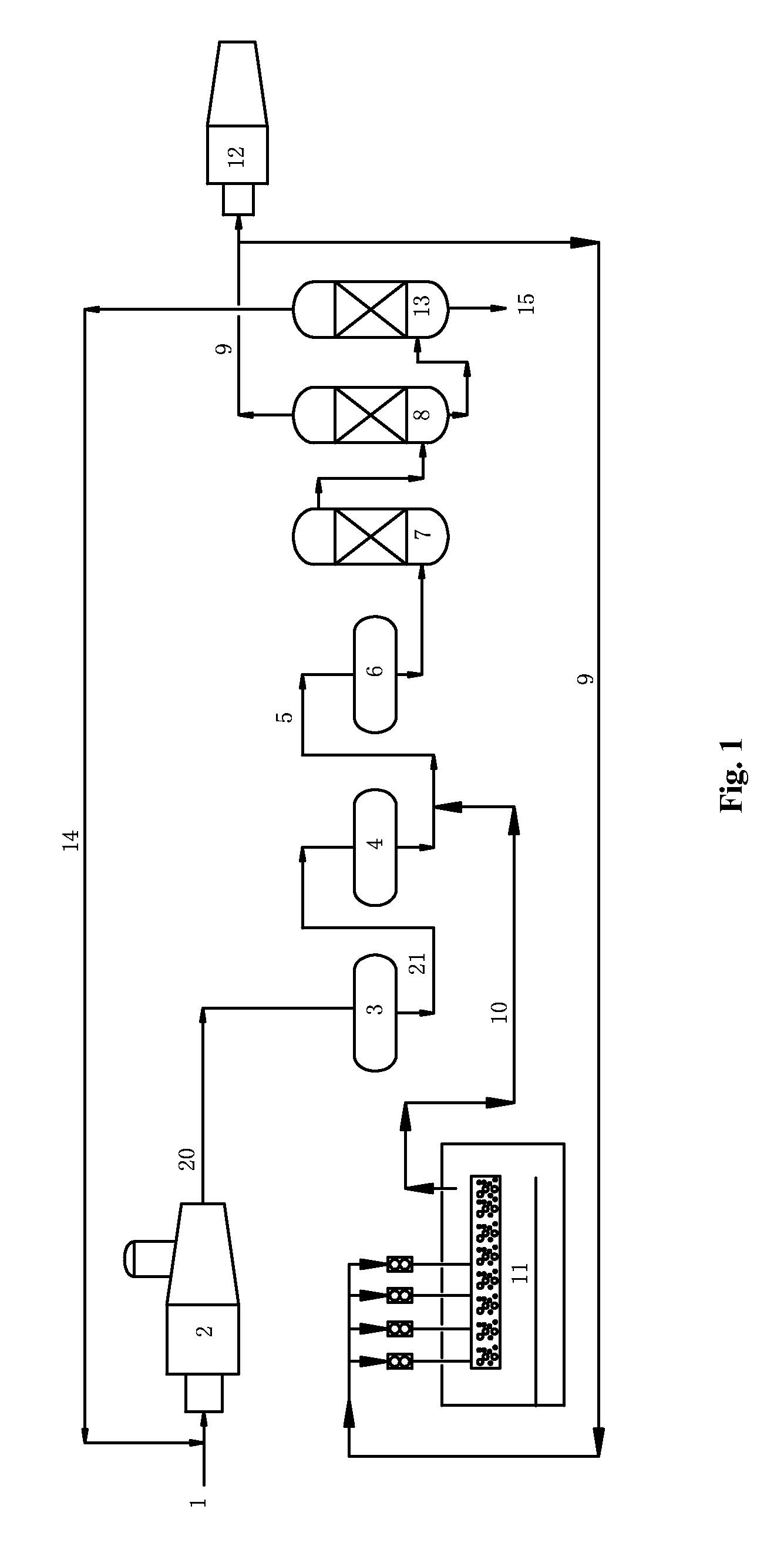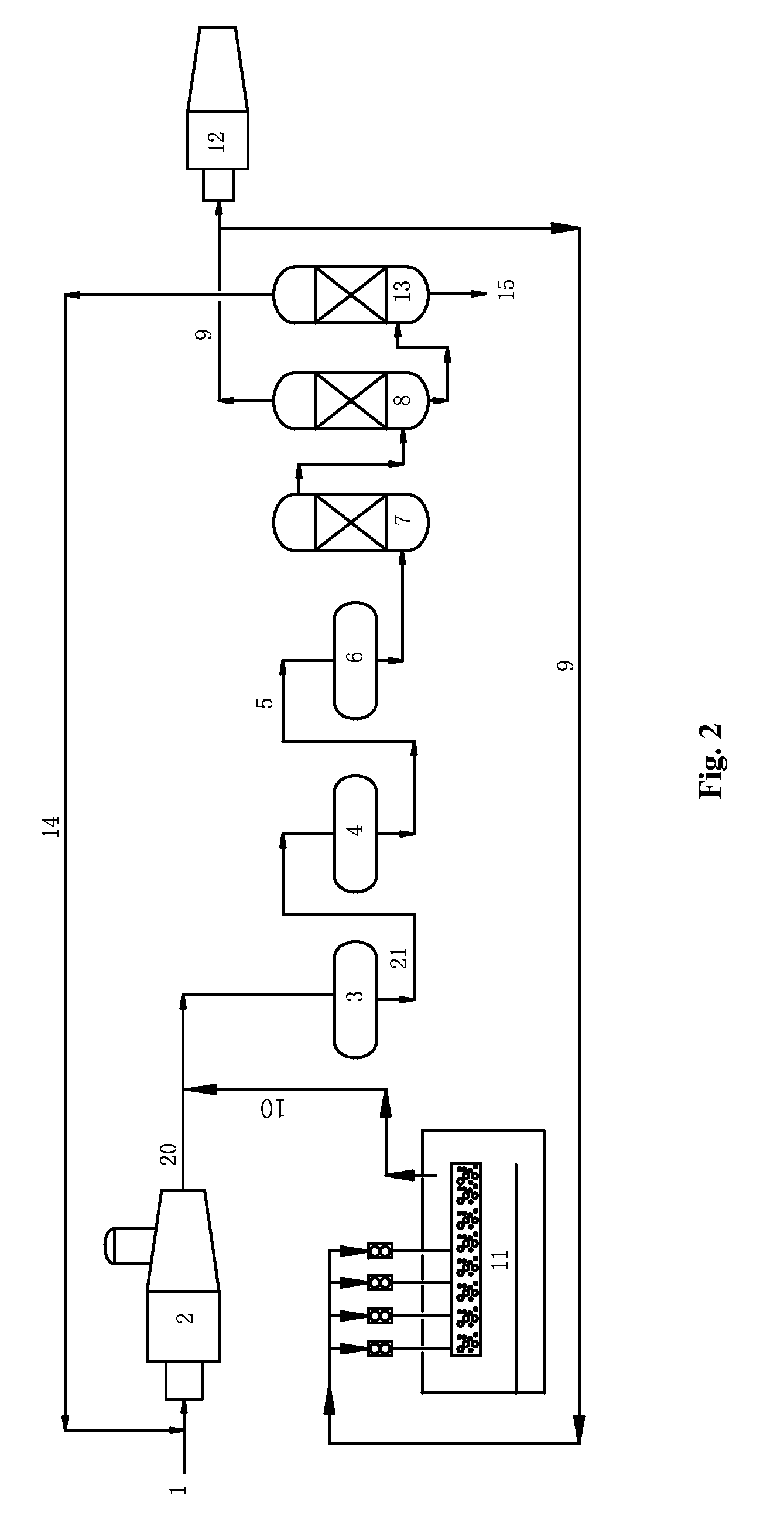Process for reducing sulfur emission of sulfur plant
a sulfur plant and sulfur technology, applied in the field of sulfur recovery, can solve the problems of low sulfur emission rate, fragile solid sulfur formed from undegassed sulfur, and severe restrictions on sulfur emission in developed countries, and achieve the effect of low operating cost and small investmen
- Summary
- Abstract
- Description
- Claims
- Application Information
AI Technical Summary
Benefits of technology
Problems solved by technology
Method used
Image
Examples
example 1
[0080]The procedure of this example was as illustrated FIG. 1. This procedure included thermal reaction section, catalytic reaction section and tail-gas purification section.
[0081]In the thermal reaction section, acid gas (1) comprising 90 (v / v) % of H2S was partially combusted in the reaction furnace (2), wherein about one third of H2S was converted into SO2. At 1250° C., H2S reacted with SO2 according to Claus reaction so as to produce element sulfur and a process gas (20), wherein the element sulfur was sent to liquid sulfur tank (11) to obtain liquid sulfur. This process gas (20) comprised, by volume, H2S 6%, SO2 2.5%, organo-sulfur compounds 0.5%.
[0082]The process gas (20) was introduced into the first converter (3) (operation conditions: 300° C., space velocity 800 h−1) and then the second converter (4) (operation conditions: 250° C., space velocity 800 h−1) of the catalytic reaction section. After the Claus catalytic conversion (in the presence of alumina-based Claus catalyst...
example 2
[0086]The procedure of this example was as illustrated FIG. 1. This procedure included thermal reaction section, catalytic reaction section and tail-gas purification section.
[0087]In the thermal reaction section, acid gas (1) comprising 75 (v / v) % of H2S was partially combusted in the reaction furnace (2), wherein about one third of H2S was converted into SO2. At 1250° C., H2S reacted with SO2 according to Claus reaction so as to produce element sulfur and a process gas (20), wherein the element sulfur was sent to liquid sulfur tank (11) to obtain liquid sulfur. This process gas (20) comprised, by volume, H2S 8%, SO2 3%, organo-sulfur compounds 1%.
[0088]The process gas (20) was introduced into the first converter (3) (operation conditions: 320° C., space velocity 800 h−1) and then the second converter (4) (operation conditions: space velocity 250° C., 800 h−1) of the catalytic reaction section. After the Claus catalytic conversion (in the presence of alumina-based Claus catalyst—LS-...
example 3
[0092]The procedure of this example was as illustrated FIG. 1. This procedure included thermal reaction section, catalytic reaction section and tail-gas purification section.
[0093]In the thermal reaction section, acid gas (1) comprising 55 (v / v) % of H2S was partially combusted in the reaction furnace (2), wherein about one third of H2S was converted into SO2. At 1250° C., H2S reacted with SO2 according to Claus reaction so as to produce element sulfur and a process gas (20), wherein the element sulfur was sent to liquid sulfur tank (11) to obtain liquid sulfur. This process gas (20) comprised, by volume, H2S 4%, SO2 2%, organo-sulfur compounds 0.3%.
[0094]The process gas (20) was introduced into the first converter (3) (operation conditions: 320° C., space velocity 800 h−1) and then the second converter (4) (operation conditions: 250° C., space velocity 800 h−1) of the catalytic reaction section. After the Claus catalytic conversion (in the presence of alumina-based Claus catalyst—L...
PUM
| Property | Measurement | Unit |
|---|---|---|
| concentration | aaaaa | aaaaa |
| concentration | aaaaa | aaaaa |
| temperature | aaaaa | aaaaa |
Abstract
Description
Claims
Application Information
 Login to View More
Login to View More - R&D
- Intellectual Property
- Life Sciences
- Materials
- Tech Scout
- Unparalleled Data Quality
- Higher Quality Content
- 60% Fewer Hallucinations
Browse by: Latest US Patents, China's latest patents, Technical Efficacy Thesaurus, Application Domain, Technology Topic, Popular Technical Reports.
© 2025 PatSnap. All rights reserved.Legal|Privacy policy|Modern Slavery Act Transparency Statement|Sitemap|About US| Contact US: help@patsnap.com



